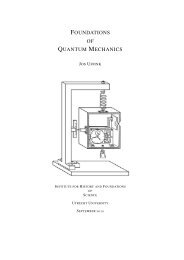Simple analytical models of glacier-climate interactions - by Prof. J ...
Simple analytical models of glacier-climate interactions - by Prof. J ...
Simple analytical models of glacier-climate interactions - by Prof. J ...
Create successful ePaper yourself
Turn your PDF publications into a flip-book with our unique Google optimized e-Paper software.
Problem ice-sheet pr<strong>of</strong>ile (P 2)<br />
For the steady-state radial velocity we now have:<br />
d (r H U r ) = b R r2<br />
R<br />
d r → U r =<br />
b R<br />
3 R H-1 r 2 (P 2.1)<br />
This can be combined again with the expression for the vertical mean ice velcocity in the<br />
case <strong>of</strong> simple shearing flow:<br />
U r = - A* H n+1 d H<br />
d r<br />
n<br />
(P 2.2)<br />
We get<br />
1+2/n<br />
H<br />
dH<br />
dr<br />
= -<br />
1/n<br />
b R<br />
3 R A*<br />
r 2/n (P 2.3)<br />
Integration with respect to r yields<br />
n<br />
2n+2 H 2+2/n - H 0<br />
2+2/n = - n<br />
n+2<br />
1/n<br />
b R<br />
3 R A*<br />
r 1+2/n , (P 2.4)<br />
or<br />
H 2+2/n - H 0<br />
2+2/n = - 2n+2<br />
n+2<br />
1/n<br />
b R<br />
3 R A*<br />
r 1+2/n . (P 2.5)<br />
Next we have to apply a boundary condition, namely H = 0 at r = R. This leads to a<br />
relation between the ice thickness in the centre and the ice-sheet radius:<br />
H 0<br />
2+2/n = 2n+2<br />
n+2<br />
1/n<br />
b R<br />
3 R A*<br />
R 1+2/n . (P 2.6)<br />
The final solution then becomes<br />
H(r) = 2n+2<br />
n+2<br />
n/(2n+2)<br />
b R /(3 R A*) 1/(2n+2) R 1+2/n - r 1+2/n n/(2n+2) . (P 2.7)<br />
For n=3 we have:<br />
29
















